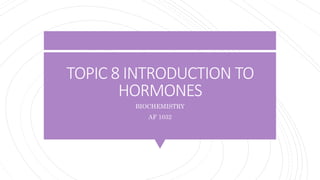
PART 1 TOPIC 8 INTRODUCTION TO HORMONES.pptx
- 1. TOPIC 8 INTRODUCTION TO HORMONES BIOCHEMISTRY AF 1032
- 2. LEARNING OUTCOMES At the end of this lecture, students will be able to: State the definition and characteristics of hormones. Explain intracellular and cell membrane hormone receptor Discuss the role of feedback loops and humoral, hormonal and neural stimuli in hormone control. Identify different types of hormones and its functions
- 3. WHATISA HORMONE? Definition: hormones are chemical that act as messengers that coordinate different functions in the body. Hormones are generally made up of amino acids, proteins, fatty acids or can be classified as steroids.
- 5. CHARACTERISTICS OFHORMONES They act on target organs that may be distally located Hormones show high degree of specificity They are secreted in response to specific stimuli They are non-antigenic Most of the hormones have low molecular weight and therefore they can easily pass out through blood capillaries They act in very low concentration but their effect is long lasting Once their function is over, hormones are readily destroyed by enzymatic action or are inactivated or excreted. Hormones are not species-specific because hormones extracted form animals are found to be effective in man.
- 6. CELL SIGNALING The effects of hormones depends on how they are released. Signalling effects can be classified into the following: Autocrine: hormone act on cell that secreted it Paracrine: hormone act on nearby cell without having to enter the blood circulation Intracrine: hormone is produced in the cell and acts intracellularly means inside the cell. Endocrine: hormone act on target cells once it is released from the perspective glands into the bloodstream.
- 7. PATHWAYSOF HORMONE ACTION Hormones have defined molecular shape and only bind specific receptor on their target cells. Cells are therefore only affected by a hormone if they have right receptor for it. But an individual cell may be a target for more than one type of hormone When hormone bind to its receptor, this triggers a chain of events that result in changes in the cell. Mechanism of hormonal action is categorized into two: 1. Intracellular hormone receptor 2. Cell membrane hormone receptors
- 8. 1. Intracellular Hormone Receptor Intracellular hormone receptor located inside the cell Steroid hormones and thyroid hormones are lipid soluble are able to pass trough the lipid bilayer of cell membrane Steroid hormone: bind to receptors within cytosol or within nucleus. Binding generates hormone-receptor complex that moves towards the chromatin in cell nucleus. Then bind to particular segment of cell’s DNA Thyroid hormone: bind to receptors already bound to DNA. Binding of hormone-receptor complex with DNA triggers transcription of target gene to mRNA for protein synthesis.
- 10. 2.CellMembrane Hormone Receptor Water soluble (hydrophilic) hormones unable to pass through the cell membrane. They must pass their message to the receptor on the extracellular surface of the cell membrane. Therefore, they initiate a signalling cascade to second messenger for transcription of target genes to happen. In this case, hormone is the first messenger. Second messenger: cyclic adenosine monophosphate (cAMP).
- 12. REGULATION OFHORMONE SECRETION There are two types of feedback loops for hormone regulations: positive feedback and negative feedback Positive feedback: Characterized by release of additional hormone in response to an original hormone release. Example: Oxytocin 1. Oxytocin initially release to signal uterine muscles to contract, which pushes the fetus toward the cervix, causing it to stretch. 2. This, in turns, signal pituitary gland to release more oxytocin, causing labour contraction to intensify 3. The release of oxytocin decreases after the birth of the child.
- 13. REGULATION OFHORMONE SECRETION Negative Feedback Characterized by inhibition of further secretion of a hormone in response to adequate level of that hormone. More common method of hormone regulation Example: Glucocorticoid Hormones. 1. Adrenal gland release glucocorticoid hormone, as directed by hypothalamus and pituitary gland. 2. Glucocorticoid concentration in blood rise, hypothalamus and pituitary gland reduce their signal to adrenal glands to prevent additional glucocorticoid secretion.
- 15. ENDOCRINE SYSTEM There are two major categories of glands in the body - exocrine and endocrine. Exocrine Glands: have ducts that carry their secretory product to a surface. These glands include the sweat, sebaceous, and mammary glands and, the glands that secrete digestive enzymes. Endocrine Glands: The endocrine glands do not have ducts to carry their product to a surface. The secretory products of endocrine glands are called hormones Pancreas can be both exocrine and endocrine glands Exocrine function: produces enzymes that help with digestion Endocrine function: sends out hormones
- 16. Major Endocrine Glands 1. Pituitary gland 2. Pineal gland 3. Thyroid 4. Thymus 5. Adrenal glands 6. Pancreas 7. Testes 8. Ovaries
- 17. ASSIGNMENT Each topic must have: Hormone secreted and hormone function. Position/diagram of the glands. Categorize whether they are peptide hormones or steroid hormone (water soluble or Lipid soluble) Presentation will be on 20/9/2022
Notas do Editor
- Distally: Situated away from the center of the body
- Intensify: of extreme force, degree, or strength:
- Intensify: of extreme force, degree, or strength: